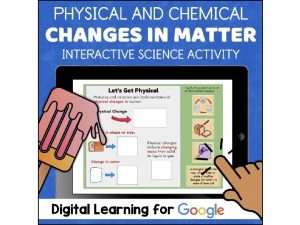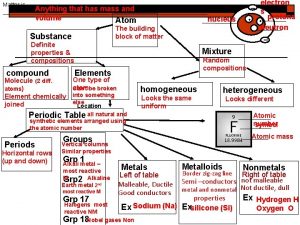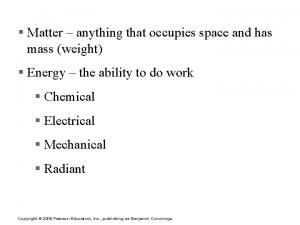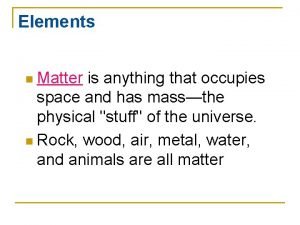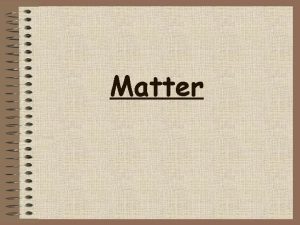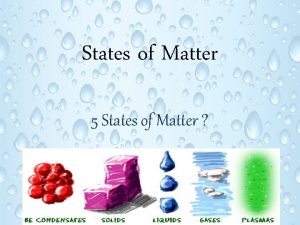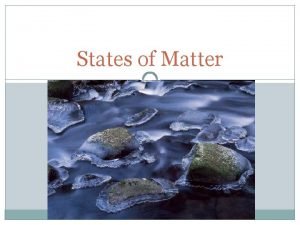7 1 States of Matter Matter is anything









- Slides: 9

7. 1 States of Matter • Matter is anything that has mass and volume. • Mass is the quantity of matter a substance or object contains. w Mass is usually measured in grams (g) or kilograms (kg). • Volume is the amount of space taken up by a substance or object. w Volume is usually measured in millilitres (m. L), litres (L), or cubic centimetres (cm 3). Comparing the basketball and bowling ball, which has more mass? Volume? See pages 246 - 247 (c) Mc. Graw Hill Ryerson 2007

7. 1 States of Matter The three familiar states (phases) of matter. Fixed mass Fixed Volume Fixed Shape Solid Yes Yes Liquid Yes No Gas Yes No No solid liquid gas See pages 246 - 247 (c) Mc. Graw Hill Ryerson 2007

The Particle Model of Matter 1. All matter is made of small particles that are too small to see. 2. There are spaces between the particles. The amount of space varies depending upon the state. 3. The particles are always moving. 4. The particles are attracted to one another. See page 248 (c) Mc. Graw Hill Ryerson 2007

The Kinetic Molecular Theory • • Kinetic energy is the energy due to motion. The Kinetic Molecular Theory (KMT) explains what happens to matter when the kinetic energy of the particles changes. w A theory provides a scientific explanation based on the results of experimentation. As the rollercoaster’s speed increases, its kinetic energy also increases. See page 249 (c) Mc. Graw Hill Ryerson 2007

The Kinetic Molecular Theory The main points of the kinetic molecular theory include: 1. 2. 3. 4. All matter is made of very small particles. There is empty space between particles. Particles are constantly moving. The particles are colliding with each other and the walls of their container. Energy makes particles move. The more energy the particles have, the faster they move and further apart they get. Solid: Particles are so tightly packed together they cannot move freely. They can only vibrate. Liquid: Particles are farther apart and they can move by sliding past each other. Gas: Particles are very far apart and move around quickly. See page 249 (c) Mc. Graw Hill Ryerson 2007

Thermal Expansion and Contraction • Thermal expansion is the increase in volume of a substance when its temperature is raised. • Thermal contraction is the decrease in volume of a substance when its temperature is lowered. Can you use the concepts of thermal expansion and contraction to explain how a thermometer works? See page 250 (c) Mc. Graw Hill Ryerson 2007

The Difference Between Heat and Temperature • Thermal energy is the total kinetic energy of all the particles in the substance. • Heat is the transfer of thermal energy between two material of different temperature. w Heat is always transferred from the substance with a higher temperature to the substance of a lower temperature. • Temperature is the average kinetic energy of the particles in a substance. See page 251 (c) Mc. Graw Hill Ryerson 2007

Changes of State Name Change of State (from _ to _) Melting Solid to liquid Evaporation Liquid to gas Condensation Gas to liquid Solidification Liquid to solid Sublimation Solid to gas Deposition Gas to solid Heat Gained • Melting point is the temperature at which solid turns to liquid. • Boiling point is the temperature at which liquid turns into gas. Heat Lost See pages 252 - 253 (c) Mc. Graw Hill Ryerson 2007

Changes of State Solid Melting Liquid Boiling Gas Take the Section 7. 1 Quiz See pages 252 - 253 (c) Mc. Graw Hill Ryerson 2007
